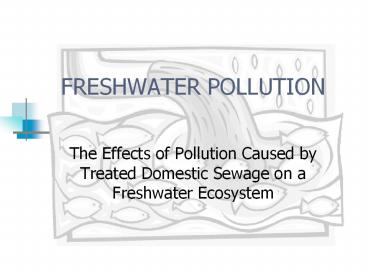FRESHWATER POLLUTION - PowerPoint PPT Presentation
1 / 21
Title:
FRESHWATER POLLUTION
Description:
FRESHWATER POLLUTION The Effects of Pollution Caused by Treated Domestic Sewage on a Freshwater Ecosystem Specific Information: The sewage treatment works is in St ... – PowerPoint PPT presentation
Number of Views:617
Avg rating:3.0/5.0
Title: FRESHWATER POLLUTION
1
FRESHWATER POLLUTION
- The Effects of Pollution Caused by Treated
Domestic Sewage on a Freshwater Ecosystem
2
Specific Information
- The sewage treatment works is in St. Jean du
Bleymard. - It serves two settlements - St. Jean du Bleymard
and Le Bleymard. - These two settlements have a combined population
of 446 (1999 census). - It also receives waste from a small holiday
village when it is open in July and August. - The total population may then reach 1200 people.
- The liquid waste from the treatment works is
discharged almost continuously in low volumes,
and diluted by the river Lot.
3
Map of Study Sites
Site 1 Upstream (control) Site 2 Outfall Site
3 5m downstream Site 4 50m downstream
4
What is a Pollutant??
- A pollutant may be natural or unnatural.
- Pollutants are not necessarily highly toxic
chemical compounds. - It is the concentration of the substance that
defines it as a pollutant. - Domestic sewage is rich in ammonium from urine
and faecal matter, phosphates from detergents and
particulate matter. - By proportion, it is approximately 45
carbohydrate, 45 fat and 10 protein.
5
Sewage Treatment Process
Tank 1
Tank 2
Tank 3
- Liquid and solid separation.
- Liquid continues onto biological treatment.
- Solid storage
- Farmers collect gtit in Autumn gtand
Winter to gtbe used as gtorganic gtfertiliser.
- Sewage is stirred by a propeller.
- This increases its surface area.
- Air (esp. Oxygen) mixed with the sewage.
6
Biological Treatment
- Urea from domestic sewage breaks down into
Ammonium (NH4). - Aerobic bacteria carry out oxidation reactions,
converting the ammonium ions to nitrate. - The reactions
- 2NH4 3O2 ? 2NO2- 4H
- (Carried out by nitrosomonas)
- Ammonium is used as food for Nitrosomonas to
produce nitrite (NO2-).
- 2NO2- O2 ? 2NO3-
- (Carried out by nitrobacter)
- Nitrobacter use the Nitrites from the previous
reaction and produce Nitrates (NO3-). - Both reactions use up Oxygen.
- Nitrosomonas and nitrobacter occur naturally in
watercourses therefore if the treatment process
is insufficient, the ammonia will be converted to
nitrate and cause Oxygen depletion in the
receiving water.
7
Abiotic Hypothesis
8
Biotic Indicators
- There are a huge diversity of invertebrates
living in rivers. - They have a range of tolerances to different
water qualities, especially different levels of
oxygen concentrations. - Therefore there are Indicator Species which can
help determine the long term quality of the river
water. - Biological Monitoring Party Score (BMWP) can be
used as a biotic index. Invertebrates with a low
BMWP can tolerate low levels of Oxygen and are
therefore good indicators of poor water quality.
9
Aims
- To determine the effects of point source organic
pollution from a small rural sewage treatment
works on the water quality of an upland stream. - To investigate the effects of water quality
changes on stream fauna.
10
Objectives
- To determine the susceptibility of freshwater
invertebrates to organic pollution, using
indicator species to give an indication of the
extent of long term pollution. - To determine the effects of pollution on species
diversity and abundance.
- To determine how treated sewage affects the
abiotic conditions - Oxygen concentration
- Temperature
- pH
- Ammonium
- Nitrates
- Phosphates
- Dissolved Load
11
Species we may find!!
12
Stonefly nymph
- Stonefly nymphs prefer rocky, stony, or gravel
bottoms in cool, well-oxygenated, swift-moving
streams or small rivers. Any effluent that
reduces the oxygen content of the stream quickly
kills the nymphs. - BMWP 10
13
Flattened Mayfly Nymph
- These are only found in very clean water
containing lots of oxygen. They absorb oxygen
from the water through their gills. - They are primary consumers that eat plants and
algae. - BMWP 10
14
Cased caddis Fly Larvae
- Caddisflies use silk (like butterflies) to build
cases from gravel, twigs, needles, or sand.
Different species build distinct cases, but they
often lose them when removed from a stream. - BMWP 8 -10
15
Cranefly Larvae
- Up to four inches long with a Fleshy, plump,
rounded segmented body - Its digestive track (internal organs) can be seen
moving back and forth as it crawls. - No legs and the back end usually has several
extensions or finger-like lobes. - BMWP 5
16
Flatworms
- Flatworms are unsegmented worms with flattened
bodies. - Their flatness allows them to shelter beneath
stones. - Being flat increases the area of skin exposed to
the water, which improves the flatworm's oxygen
uptake. - BMWP 5
17
Freshwater Mite
- Tiny animals related to spiders.
- Up to 8mm.
- They have an oval body and 8 legs.
- Many are brightly coloured.
- BMWP 4
18
Leeches
- Flat, Worm-like, segmented body.
- Many are scavengers or feed on other
invertebrates. - Suckers at both ends are used for attachment,
feeding, and locomotion. - They swim gracefully and quickly in an
up-and-down motion. - BMWP 3
19
Red Midge Larvae (Bloodworms)
- These are sometimes called 'bloodworms' because
of their bright red colour, but they are not
worms at all. - They are midge larvae.
- They eat dead organic matter and can tolerate
very low oxygen levels. - BMWP 2
20
Tubifex Worms
- These are thread-like worms that live in the mud
on stream bottoms. - They are filterfeeders
- They can tolerate extremely low levels of oxygen
and are therefore found in polluted water. - BMWP 1
21
- This shows freshwater fauna as indicators of
river pollution.






























